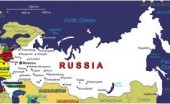Re Ian Bremmer 'Could third-party candidates upend the 2024 US election?' 3 April The current political movement in the USA…
The Arctic October 2023 –
Written by Diana Thebaud Nicholson // March 17, 2024 // Arctic and Antarctic // Comments Off on The Arctic October 2023 –
17 March
How Ukraine war and sanctions on Russia put Arctic cooperation on ice
After two years of frosty relations and a stalled LNG project in the wake of Russia’s invasion of Ukraine, there is sign of a thaw amid pressing climate concerns: Arctic Council working group meetings are resuming virtually
Nong Hong, executive director and senior fellow at the Institute for China-America Studies in Washington, US, and a research fellow at the China Institute, University of Alberta, Canada
(SCMP) Last month, the Arctic Council broke the ice by agreeing to reconvene its working group meetings virtually, nearly two years after seven of its eight members, including the US, halted participation in protest against the invasion of Ukraine by Russia, which held the council chairmanship then.
The working groups had been relying on “written procedures” for the last six months, after Norway took over the chairmanship and found ways to resume project work.
While Russia has not yet considered withdrawing from the Arctic Council, it has suspended its annual payments to it.
Amid Russia’s unpredictability, Greenland is seeking stronger ties with the United States and Canada, and pushing to establish a high-level Arctic-North American forum that would include leaders from all the indigenous territories. Meanwhile, US troops stationed in Alaska, redesignated as the Arctic division in 2022, are developing as an Arctic force and collaborating with Norway, Canada, Finland and Sweden in joint exercises.
Despite the geopolitical and economic shifts, however, scientific cooperation in the Arctic remains one of the few areas where the international community shares more common concerns than divergent views.
There is a long tradition of scientific collaboration between nations in this region, and the conflict in Ukraine has presented a unique challenge for climate researchers and scientists. Official Arctic Council meetings have been paused since May 2022 and with that, scientific cooperation among the eight Arctic states at the institutional level.
The Arctic Council’s resumption of project-level work is both significant and timely, and will help the council to fulfil its mandate as the leading and permanent forum for Arctic governance. The effectiveness of the Arctic Council’s working groups in tackling environmental, climatic and social development issues is also vital for the welfare of the Arctic communities.
23 February
Greenland Unveils New Arctic Strategy
(High North News) Greenland’s government, Naalakkersuisut, has announced a new foreign relations, security, and defence strategy for 2024-2033. The strategy identifies closer links between Greenland and Arctic areas in North America as a priority. These include Alaska—which the strategic document sees as an inspiration in education and the mineral sector—and the Canadian Arctic territories and regions of the Yukon, Northwest Territories, Nunavut, and Nunavik. The government proposes the establishment of a new forum, the Arctic North American Forum, and aims to strengthen cooperation with Iceland, emphasizing the importance of maintaining the Arctic as a low-tension area.
21 February
A China-Russia Arctic Alliance? Not So Fast.
Despite lofty declarations of mutual interests in the Arctic, there have been significant cracks in this regional relationship.
(The Diplomat) With the Arctic finding itself under ever greater global scrutiny due to climate change, and opening up to increased economic activities, from shipping to mining to fishing, the question of whether great power competition is spilling over into the far north has assumed greater importance. One aspect of this attention has been the idea of a probable, and perhaps even inevitable, Arctic pact between China and Russia, one based on mutual northern interests and shared mistrust of the West.
At first glance, there is much evidence to support this view, especially with Beijing declining to condemn the Russian invasion of Ukraine, and instead adopting a nebulous policy of neutrality toward the conflict. China and Russia are both pushing back against what they perceive as NATO militarism and expansionism in the Arctic. The Polar Silk Road, which the two states began to jointly develop after 2017, was meant to further enhance Sino-Russian boreal cooperation, centering on the Northern Sea Route connecting Asia and Europe via the waters abutting Siberia.
2023
14 November
China’s Polar Silk Road: Long Game or Failed Strategy?
By Erdem Lamazhapov, Iselin Stensdal and Gørild Heggelund
(Arctic Institute) The events of 2022 proved to be a year of great geopolitical changes. In February 2022, just days before Vladimir Putin launched his full-scale invasion of Ukraine, Xi Jinping and Putin met in Beijing, where they discussed among other things the development of the Polar Silk Road (PSR) The PSR was jointly announced in 2017) The Arctic was declared as a potential area of cooperation between the two countries, and the PSR was considered by some as the fulcrum of the Russo-Chinese cooperation. In March 2023, a year after the previous visit, Xi Jinping again visited Russia, marking China’s continued commitment as Russia’s partner – albeit not a partnership without limits. As Russia indicated a strong desire for China’s presence in the Arctic, the PSR has largely disappeared from the official Chinese discourse, raising more questions about China’s long-term intentions with its Arctic policy and its wider strategic approach to the global order. Has the PSR failed, or are we merely witnessing a hurdle for China’s long-term strategy in the Arctic?
19-21 October
2023 Arctic Circle Assembly
The Arctic Circle Assembly is the largest annual international gathering on the Arctic, attended by more than 2000 participants from over 60 countries. The Assembly is held every October in Harpa Concert Hall and Conference Center, Reykjavík, Iceland.
The 2023 Assembly Program
More than 700 speakers in over 200 Sessions will participate in the 2023 Arctic Circle Assembly
The Arctic Convenes in a Restless World
(High North News) Reykjavik – In an unclear geopolitical landscape, Arctic leaders, researchers, and indigenous peoples meet in Reykjavik to create clarity and form alliances. Russia is taking greater risks with nuclear fuel, and we are taking a closer look at the ghost of depopulation.
Over 2000 people convened in Reykjavik, Iceland, for the tenth Arctic Circle conference from Thursday to Saturday. Renewable energy, cooperation, Russia, China, and geopolitics are topics on the agenda. To name a few.
That is to say, there were supposed to be over 2,000, but many of those who had their name on the program had to capitulate for Iceland’s legendary wind. All flights to the island were canceled on the opening day, and ships could not dock.
Such is life in the North. Journalist Astri Edvardsen and I had luckily landed before the storm.
The Arctic Council was one of the dominating topics of discussion on Thursday, and Norway’s handling of the takeover of the chairship from Russia was praised.
The climate crisis was also in focus. The United Arab Emirates Special Envoy for Climate and COP 28 President believes that the Arctic is the frontline for climate change.
We also learned more about nuclear power while in Iceland. Some calling it a “Nuclear renaissance”.
And speaking of nuclear power: Just weeks after sending crude oil on non-ice class tankers through the Arctic, Russian authorities shipped nuclear fuel across the Northern Sea Route on a cargo ship not specialized in transporting nuclear fuel.
19 October
Rising temps and tensions in the Arctic
As leaders convene in Reykjavik, Iceland, for the Arctic Circle Assembly, geopolitical tensions are rising as fast as the Arctic’s sea level.
(GZERO media) Historically, Arctic diplomacy has been shielded from external matters. But melting sea ice is opening up new military, trade, and extraction opportunities up north, pitting NATO Arctic countries against China and Russia, which have been proactively showing dominance in the region.
China’s Arctic presence is focused on resource extraction and faster shipping routes to Europe. It has teamed up with Russia, which chairs the Arctic Coast Guard and has begun operating joint military vessels off the coast of Alaska.
Since invading Ukraine, Russia has been withdrawing from intergovernmental bodies in the Arctic, including the Nuclear Arctic Safety Program and the Barent Euro-Arctic Council. Representatives at this week’s meeting are expected to decide the future of the most important Arctic institution, the Arctic Council. The US has pushed to reintegrate Russia into the forum, but other NATO members have been unwilling to include Russia in since its invasion.
The Graphic Truth: Shipping volume through the Russian Arctic
Climate change has opened Arctic shipping channels that can be navigated by freighters without icebreakers for several months a year – and year-round with icebreakers. Canada and Russia dominate the region, but Moscow is much more aggressively exploiting the economic opportunities there.
Taking the high-latitude route over Russia can shave 5,600 miles off a voyage from Europe to China, and as sea ice melt accelerates, the economic viability grows. Total shipping volumes along the Arctic route rose steadily between 2019 and 2020, and immediately after Russia invaded Ukraine, despite the frigid March conditions, the Arctic corridor saw its highest-ever volume of shipping in 2022.
Canada and the United States, meanwhile, have faced criticism for underinvestment in Arctic security. Canada, for example, lacks sufficient early warning systems to detect missile attacks coming over the North Pole — which is dangerous, given that the Arctic is essentially split between Russia and NATO countries.
16 October
Russia Sends Nuclear Fuel Across Arctic on Ship with History of Safety Violations
Weeks after sending crude oil on non-ice class tankers through the Arctic, Russian authorities shipped nuclear fuel across the Northern Sea Route on a cargo ship not specialized in the transport of nuclear fuel. Ship records also show a host of safety deficiencies during past inspections. The nuclear fuel traveled from Murmansk to Pevek to resupply the floating nuclear power plant Akademik Lomonosov.



